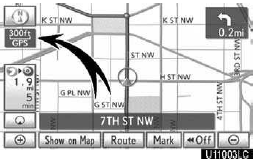Limitations of the navigation system
This navigation system calculates the current vehicle position using satellite signals, various vehicle signals, map data, etc. However, the accurate position may not be shown depending on the satellite condition, road configuration, vehicle condition or other circumstances. The Global Positioning System (GPS) developed and operated by the U.S. Department of Defense provides an accurate current vehicle position, normally using 4 or more satellites, and in some case 3 satellites.
The GPS system has a certain level of inaccuracy. While the navigation system will compensate for this most of the time, occasional positioning errors of up to 300 feet (100 m) can and should be expected.
Generally, position errors will be corrected within a few seconds.

When your vehicle is receiving signals from the satellites, the “GPS” mark appears at the top left of the screen.
The GPS signal may be physically obstructed, leading to inaccurate vehicle position on the map display. Tunnels, tall buildings, trucks, or even the placement of objects on the instrument panel may obstruct the GPS signals.
The GPS satellites may not send signals due to repairs or improvements being made to them.
Even when the navigation system is receiving clear GPS signals, the vehicle position may not be shown accurately or inappropriate route guidance may occur in some cases.
NOTICE
The installation of window tinting may obstruct the GPS signals. Most window tinting contains some metallic content that will interfere with GPS signal reception of the antenna in the instrument panel. We advise against the use of window tinting on vehicles equipped with navigation systems.
(a) Accurate current vehicle position may not be shown in the following cases:
When driving on a small angled Y− shaped road.
When driving on a winding road.
When driving on a slippery road such as in sand, gravel, snow, etc.
When driving on a long straight road.
When motorway and surface streets run in parallel.
After moving by ferry or vehicle carrier.
When a long route is searched during high speed driving.
When driving without setting the current position calibration correctly.
After repeating a change of direction by going forward and backward, or turning on a turntable in the parking lot.
When leaving a covered parking lot or parking garage.
When a roof carrier is installed.
When driving with tire chains installed.
When the tires are worn.
After replacing a tire or tires.
When using tires that are smaller or larger than the factory specifications.
When the tire pressure in any of the four tires is not correct.
INFORMATION
If your vehicle cannot receive GPS signals, you can correct the current position manually. For information on setting the current position calibration, see page 346.
(b) Inappropriate route guidance may occur in the following cases:
When turning at an intersection off the designated route guidance.
If you set more than one destination but skip any of them, auto reroute will display a route returning to the destination on the previous route.
When turning at an intersection for which there is no route guidance.
When passing through an intersection for which there is no route guidance.
During auto reroute, the route guidance may not be available for the next turn to the right or left.
It may take a long time to operate auto reroute during high speed driving. In auto reroute, a detour route may be shown.
After auto reroute, the route may not be changed.
An unnecessary U−turn may be shown or announced.
A location may have multiple names and the system will announce one or more.
Some routes may not be searched.
If the route to your destination includes gravel, unpaved roads or alleys, the route guidance may not be shown.
Your destination point might be shown on the opposite side of the street.
When a portion of the route has regulations prohibiting the entry of the vehicle that vary by time or season or other reasons.
The road and map data stored in your navigation system may not be complete or may not be the latest version.
After replacing a tire, implement the operation described in the “TIRE CHANGE CALIBRATION”.
This navigation system uses tire turning data and is designed to work with factory− specified tires for your vehicle. Installing tires that are larger or smaller than the originally equipped diameter may cause inaccurate display of the vehicle’s position.
The tire pressure also affects the diameter of the tires so please make sure the tire pressure of all four tires is correct.
See also:
Using automatic air conditioning system
Press the “AUTO” button.
The air conditioning system will operate, and air outlets and fan speed will
be adjusted automatically.
Press “
” on the “TEMP” button to increase the temp ...
Screen adjustment
The contrast and brightness of the
screen display and the image the cam-
era displays can be adjusted. The display
can also be turned off, and/or changed
to either day or night mode.
SCREEN SETTI ...
Tire Limited Warranty
OBTAINING WARRANTY SERVICE
The tires that come as original equipment on your vehicle are warranted by their
manufacturer and not Lexus.
Please refer to the tire warranty statement included with th ...
